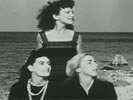Eye For Film >> Movies >> At Land (1944) Film Review
At Land
Reviewed by: Chris

A woman lies on the sand, left there by the tides and waves (and in a pose that would be copied in From Here To Eternity). She reaches up across tree roots and makes a difficult climb. Only to discover herself climbing horizontally along a long dinner table as bourgeois black-tie guests chat and drink and smoke, oblivious to her. At the top of the table, a man is playing chess but abandons the game. Fascinated, she gazes at board, the pieces moving unaided. The woman chases a pawn as it falls to the floor. Falls down a waterfall. Is lost.
She meets a man on a path through a forest. They chat and go to a big house - at his suggestion - where the furniture is covered with white shrouds, as if no one lives there. (The inside of the house is quite grand, although from outside it is a mere wooden shack). She stares at an older man lying under a white sheet.

The woman descends the cliffs to the sand dunes and the beach. Two women are playing a relaxed chess game and having a good time. She caresses their hair seductively. They play without needing to look at the board. The woman then takes a pawn and runs across the dunes, triumphantly recalling earlier scenes but leaving only footprints in the sand.
Maya Deren’s second short film is perhaps the only one to resemble her more famous Meshes Of The Afternoon in terms of structure and style. While both experimental films have a surrealist narrative that is suggestive rather than literal, the oppressive, frightening tone of Meshes is here replaced with one of joyous discovery. In Lacanian terminology, it celebrates a healthy return to an inner essence. In this it is almost the reverse of the psychotic nightmare of Meshes. It has also been seen as one first films addressing feminine subjectivity, although an anti-materialist reading would be equally possible (Deren had also been a left-wing political activist in the Thirties).
In her classic text, Cinematography: The Creative Use Of Reality, Deren says: “In my At Land, it has been the technique by which the dynamic of the Odyssey is reversed and the protagonist, instead of undertaking the long voyage of search for adventure, finds instead that the universe itself has usurped the dynamic action which was once the prerogative of human will, and confronts her with a volatile and relentless metamorphosis in which her personal identity is the sole constancy.”
Cinematically, the unmatched shots also create a sense of disorientation in time and space. The viewer is forced to form their own ‘story’ or ‘meaning’ according to her or his own ingenium. The use of surreal structure for Deren was not so much an artistic preference as a belief that cinema needs to find its own instrument as an art form, to relinquish its reliance on, “narrative disciplines it has borrowed from literature,” and its, “timid imitation of the causal logic of narrative plots.”
The fact that At Land works so well reminds us that Meshes was no accident: Deren understood the way symbols are used by the subconscious well enough to elicit direct, meaningful responses in an audience. Sadly for cinephiles, Deren mostly moved back to her other love, that of the dance, in her use of film thereafter. Yet it is particularly her two early surrealist classics that continue to provide inspiration to viewers and filmmakers alike, such that she is still often referred to as the ‘Mother of US-Avant-Garde.’ She developed a new vocabulary of film images and a new syntax of film techniques. Things she continued to strive for and lecture on until the end of her tragically short life.
Reviewed on: 14 Apr 2009














